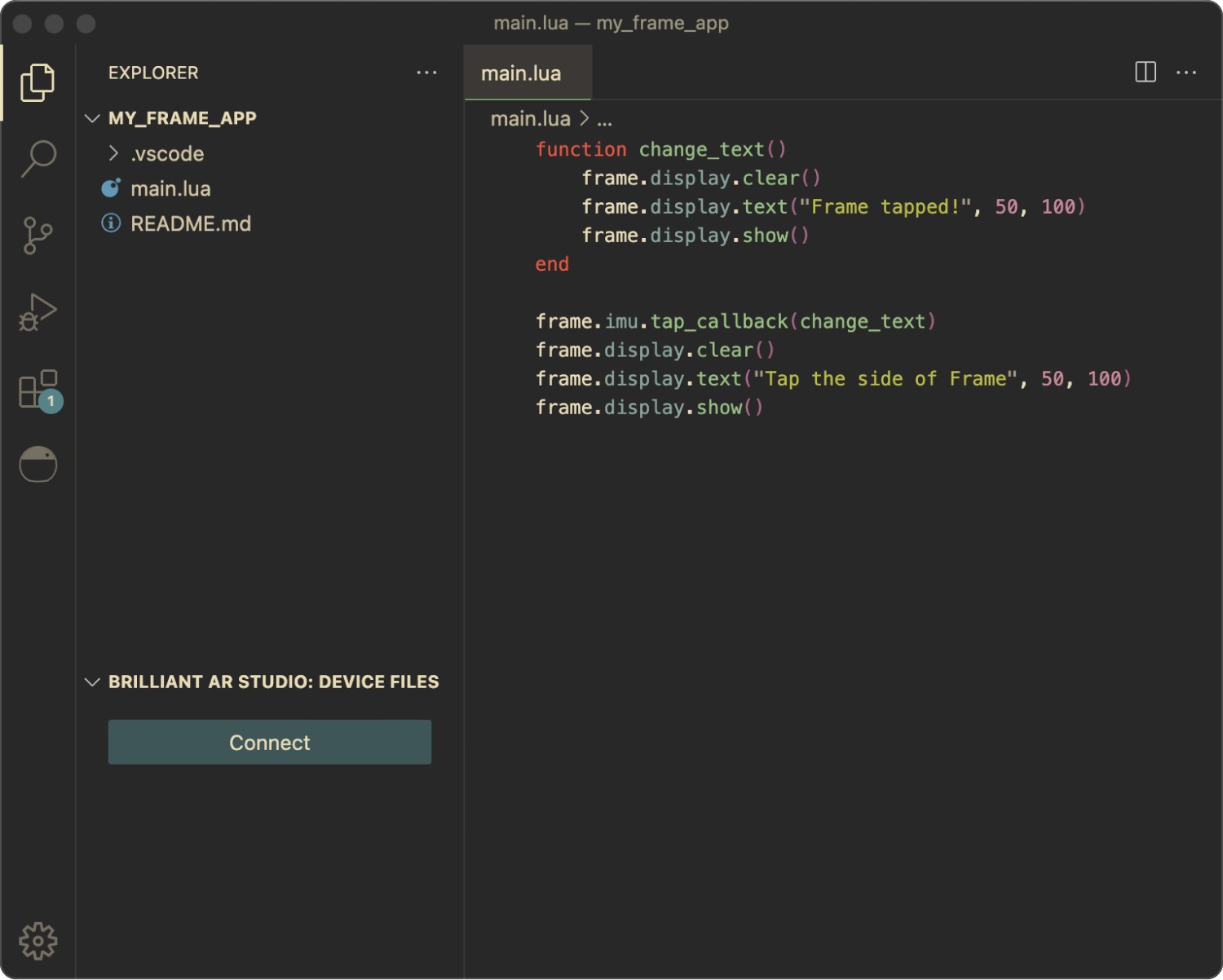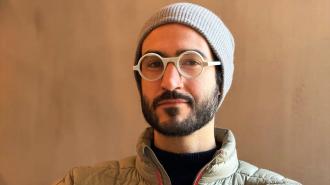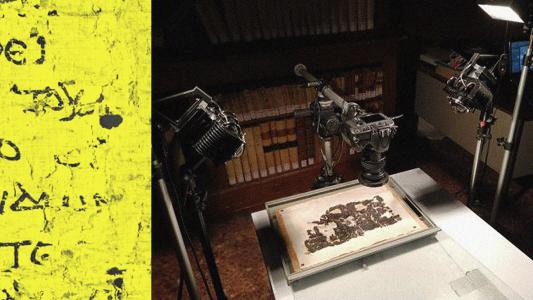“We think that this thing should be about more than whales flying through the sky or a T-rex dancing on your tabletop. It should be about bringing AI in front of the eye to elevate context and make you a bit of a superhuman. This symbiosis of humanity and artificial intelligence could be a great thing.”
That’s Bobak Tavangar. He’s the CEO of Brilliant Labs, a Singapore-based company that recently shipped its first wide-audience product, augmented reality smart glasses called Frame, into an increasingly crowded market. Amazon and Meta have both launched their own smart glasses (Echo Frames and Ray-Ban Stories, respectively). Microsoft and Apple have also entered the mixed-reality space. Meanwhile, Humane’s AI Pin and Rabbit’s R1 are promising to be AI assistants in gadget form (at least, one day).
But Tavangar doesn’t see these as competition — not in the traditional sense. He told Freethink that Brilliant Labs is “walking a different path.” Their aim isn’t to offer a new, and more expensive, way to watch movies, play games, and post on social media. They want to create a product that will one day “intertwine our lives” with AI so that the technology can “proactively help us no matter what our goals and ambitions are.”
And with Frame, Brilliant Labs sought to build that philosophy into every decision. Here’s how.
A new Frame of mind
It starts with the design. Unlike the smart glasses of yesteryear — which sported awkward add-ons that looked more cyberpunk cosplay than everyday fashion — Frame looks like a standard pair of Windsor glasses. In fact, Brilliant Labs specifically chose circular eye rims to reference the spectacles worn by historic figures such as Gandhi, Winston Churchill, John Lennon, Steve Jobs, and, of course, Groucho Marx.
“There are these people in history who have done very consequential things for humanity — culturally, economically, politically, and technologically,” Tavangar says. “There’s a lineage there, and we wanted to pay homage to that.”
The only discernible differences to Frame’s historic inspirations are a slightly thicker frame and rounded temple tips. But these alterations to the classic style have hidden all the hardware necessary to bring AI to the eyes. Those rounded-off temple tips are actually dual 105mAh batteries. Frame’s bridge houses a microphone and 720p low-power camera. The frames themselves allow for the inclusion of AR optics and 640×400 micro OLED displays.
Tech heads may feel underwhelmed by some of those numbers, especially when comparing them to what state-of-the-art mixed-reality kits bring to the table. For instance, the Apple Vision Pro’s 3D display system pumps 23 million pixels into the user’s cornea and is chockablock with cameras and scanners. And the Ray-Ban Stories sport an ultra-wide 12 MP camera set up to livestream on Facebook and Instagram.
We believe that intelligent AI agents should be aligned with how we perceive our own lives.
Bobak Tavangar
However, big doesn’t always typify better. At 600 grams, the Apple Vision Pro is designed for short bursts of intense activity, not neck-straining all-day use. Similarly, Ray-Ban Stories’ design is all about keeping the user dialed into social media platforms. Different specs, different design philosophies.
Conversely, Frame was designed to be integrated into your life as easily and seamlessly as your watch or phone. It weighs only 39 grams — within the range of a standard pair of glasses — and battery benchmark tests show the device can run a day and a half before needing a recharge.
Its camera also doesn’t record and store data. As Tavangar puts it, “We don’t want to see your life.” Instead, the camera is optimized so that the AI can recognize the visual information it needs to accurately assist its user with their inquiries and information needs.
AI: Your daily superpower
Another of Tavangar and Brilliant Labs’s goals with Frame’s design was to help people solve real-world problems in meaningful ways through the capabilities of AI. Its AR optics shine visual information directly onto the lens, providing users with the information they request, hands-free.
Brilliant Labs has combined that with Noa, an app that seamlessly ties together several different AI models through tap and voice commands. For example, OpenAI’s technology powers the device’s visual analysis, while its Whisper app offers translations, and Perplexity offers internet searches. Together, Tavangar says, this interface allows people to rapidly combine AI with the collective knowledge of the internet to help them in any endeavor, big or small, they may encounter.
“No matter what sort of challenging or stressful or emotional situations we find ourselves in, whatever it is that we’re trying to do,” Tavangar adds, “we believe that intelligent AI agents should be aligned with how we perceive our own lives. The best way to do that is to give it sensing capability that maps to our own senses.”
Tavangar shared a story of a time his young daughter burned her hand while trying to be helpful in the kitchen. With a smartphone, he would have to try to comfort his carrying daughter with one hand while searching for information to treat the burn with the other.
With Frame, he imagines a situation where, with a simple voice command, Noa can use the visual information to diagnose the burn’s severity, recommend a home remedy, and also determine if the situation warrants a doctor’s trip. All hands-free, allowing him to comfort his daughter at the same time.
Other use cases he imagines include translating signs or speech in a foreign language in real-time — no need to constantly be glancing back and forth between your phone — or asking Noa if your dinner plans correspond with the diet you promised yourself you’d follow — instead of trying to crunch the calorie calculations before the waiter returns to take your order.
“It’s simple and powerful little moments where AI can just give you a superpower,” Tavangar says.
Staying open to change
Another cornerstone of Brilliant Lab’s approach is that Frame and its software remain open source. As Tavangar explains it, there are two reasons behind this decision: one strategic, the other philosophical.
The strategic reason is simply that when you give people the tools and the freedom to create whatever they want, they do amazing things.
Brilliant Labs’ initial offering, Monocle, a “pocket-sized AR device for the imaginative hacker,” caught the attention of the online world when a group of Stanford students used it to create a real-time conversation coach. The students called it RizzGPT, which they billed as a CaaS (or “charisma as a service”).
To see what people can do with Frame, Brilliant Labs keeps it under a permissive software license and maintains a repository of code on Github. The company also keeps a robust hardware manual and a library of community projects on its website for DIY enthusiasts.
“We want to flip the script on its head so that every developer can deeply optimize their AI and software for Frame hardware,” Tavangar says.

On the philosophical side, Tavangar believes that nobody should be in a position to decide what is best for others. He gives the example of education. Every school will have its own needs and challenges, and trying to develop a single solution to match all of them can have far-reaching consequences.
Instead, by giving schools the power to build on top of the out-of-the-box software, they can craft bespoke solutions that meet their needs and tackle their challenges. That same philosophy holds for individuals, families, work offices, and so on.
“We want every single person who receives it to build on top of it,” Tavangar says. “This is too important to keep closed and just give people, as passive recipients, whatever we’ve made. Because all of our decisions have implications and consequences — whether intended or not.”
A symbiosis of humanity and AI
Will Frame be the next step in the intertwining of AI and our lives that Tavangar imagines? We’ll have to wait for the early impressions and reviews to start rolling in. We’ll also have to wait to see what coders, hackers, and other up-and-coming DIYers can create using the tools Brilliant Labs offers. Perhaps even more than other tech in this market, Frame will be what we make it.
When asked what he sees for the future, Tavangar imagines a world where AI interfaces like Noa act like an extended brain. They intimately know their users — their hobbies, predilections, relationships, family history, and so on. This AI companion could use that extensive database to help its a person plan for the future, navigate stressful work situations, and find the information they need to succeed. And because the AI knows you so intimately, the information is tailored to that person in a way that is like having “a dialogue with your own history, your own life.”
We need to spend as much time and effort thinking about our human values as we do the development of intelligent technologies.
Bobak Tavangar
While Brilliant Labs is looking into something like that — a project they call “Life Graph” — Tavangar notes it is in the early conceptual stages. Until then, Brilliant Labs will continue working on ways to bring AI into our lives in ways that assist rather than distract from what’s most important to us.
As Tavangar concludes: “We need to spend as much time and effort thinking about our human values as we do the development of intelligent technologies. I don’t think that we are thinking about how to better treat each other, how to be more compassionate, and how to be more open-hearted and generous.
“I worry that stuff is being neglected because we’re counting on technology to be the prophet that saves us. [But] that’s arguably a harder one than the technology. It’s also, I think, the most vital.”






